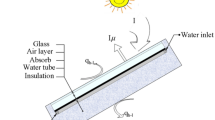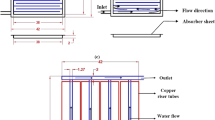Abstract
Based on a typical single pass flat plate solar air collector (FPSAC) model, the collector thermodynamic characteristic matching property between the air-side heat transfer and total heat losses is analyzed in terms of unified air-side heat transfer coefficient U b-f and total heat loss coefficient U L. Then the limit design principle of FPSACs is discussed in order to obtain high collector efficiency intercepts. The results show that, both lower and upper limit values of U L exist for obtaining an expected efficiency intercept (η0) which is lower than the maximum realizable intercept ((η0)max) with specific collector components. The case of maximum realizable intercept (η0)max can be obtained by the minimum realizable total heat loss coefficient (U L)min and a high convective heat transfer coefficient U b-f (U b-f = 200 W/(m2·K) is argued to be good collector air-side thermal performance and is considered in the present study), resulting in a minimum thermodynamic characteristic coefficient ζmin. And the maximum realizable intercepts for different component combination cases of FPSACs are obtained by numerical calculation. Besides, for FPSACs with specific airflow channels, the cases of minimum realizable (U L)min represent the limit design.
Similar content being viewed by others
References
Akpinar EK, Kocyigit F (2010). Experimental investigation of thermal performance of solar air heater having different obstacles on absorber plates. International Communications in Heat and Mass Transfer, 37: 416–421.
ANSI/ASHRAE Standard 93-2003 (2003). Methods of Testing to Determine the Thermal Performance of Solar Collectors. Atlanta: ASHRAE.
Bhushan B, Singh R (2010). A review on methodology of artificial roughness used in duct of solar air heaters. Energy, 35: 202–212.
Chamoli S, Chauhan R, Thakur NS, Saini JS (2012). A review of the performance of double pass solar air heater. Renewable and Sustainable Energy Reviews, 16: 481–492.
Deng J (2013). Optimization study on the heat transfer performance of curtain-wall form solar air heating system. Postdoctoral Research Report, Tsinghua University, China.
Deng J, Xu Y, Yang X (2015). A dynamic thermal performance model for flat-plate solar collectors based on the thermal inertia correction of the steady-state test method. Renewable Energy, 76: 679–686.
Duffie JA, Beckman WA (1991). Solar engineering of thermal processes, 2nd edn. New York: John Wiley & Sons.
El-Sebaii AA, Al-Snani H (2010). Effect of selective coating on thermal performance of flat plate solar air heaters. Energy, 35: 1820–1828.
Hachemi A (1999). Experimental study of thermal performance of offset rectangular plate fin absorber-plates. Renewable Energy, 17: 371–384.
Ho CD, Lin CS, Chuang YC, Chao CC (2013). Performance improvement of wire mesh packed double-pass solar air heaters with external recycle. Renewable Energy, 57: 479–489.
Ho CD, Yeh HM, Wang RC (2005). Heat-transfer enhancement in double-pass flat-plate solar air heaters with recycle. Energy, 30: 2796–2817.
Ho CD, Yeh CW, Hsieh SM (2005). Improvement in device performance of multi-pass flat-plate solar air heaters with external recycle. Renewable Energy, 30: 601–1621.
Hollands K, Unny TE, Raithby GD, Konicek L (1976). Free convective heat transfer across inclined air layers. ASME Journal of Heat Transfer, 98: 189–193.
Hu J, Sun X, Xu J, Li Z (2013). Numerical analysis of mechanical ventilation solar air collector with internal baffles. Energy and Buildings, 62: 230–238.
Karim MA, Hawlader M (2006). Performance evaluation of a v-groove solar air collector for drying applications. Applied Thermal Engineering, 26: 121–130.
Karsli S (2007). Performance analysis of new-design solar air collectors for drying applications. Renewable Energy, 32: 1645–1660.
Karwa R, Chauhan K (2010). Performance evaluation of solar air heaters having v-down discrete rib roughness on the absorber plate. Energy, 35: 398–409.
Kumar S, Mullick SC (2010). Wind heat transfer coefficient in solar collectors in outdoor conditions. Solar Energy, 84: 956–963.
Lin W, Gao W, Liu T (2006). A parametric study on the thermal performance of cross-corrugated solar air collectors. Applied Thermal Engineering, 26: 1043–1053.
Liu T, Lin W, Gao W, Luo C, Li M, Zheng Q, Xia C (2007). A parametric study on the thermal performance of a solar air collector with a v-groove absorber. International Journal of Green Energy, 4: 601–622.
Liu T, Lin W, Gao W, Xia C (2007). A comparative study of the thermal performances of cross-corrugated and v-groove solar air collectors. International Journal of Green Energy, 4: 427–451.
Mittal MK, Varun Saini RP, Singal SK (2007). Effective efficiency of solar air heaters having different types of roughness elements on the absorber plate. Energy, 32: 739–745.
ONG KS (1995). Thermal performance of solar air heaters—Mathematical model and solution procedure. Solar Energy, 55: 93–109.
Pakdaman MF, Lashkari A, Tabrizi HB, Hosseini R (2011). Performance evaluation of a natural-convection solar air-heater with a rectangular-finned absorber plate. Energy Conversion and Management, 52: 1215–1225.
Swinbank WC (1964). Long-wave kinematic viscosity from clear skies. Quarterly Journal of the Royal Meteorological Society, 90: 488–493.
Tanda G (2011). Performance of solar air heater ducts with different types of ribs on the absorber plate. Energy, 36: 6651–6660.
Xia BL, Zhao DL, Dai YJ, Li Y (2011). Study on a flat plate solar air collector with baffles. Journal of Shanghai Jiaotong University, 45: 870–874. (in Chinese)
Yang M, Wang P, Yang X, Shan M (2012). Experimental analysis on thermal performance of a solar air collector with a single pass. Building and Environment, 56: 361–369.
Yang M, Yang X, Li X, Wang Z, Wang P (2014). Design and optimization of a solar air heater with offset strip fin absorber plate. Applied Energy, 113: 1349–1362.
Yeh HM, Ho CD (2009). Solar air heaters with external recycle, Applied Thermal Engineering, 29: 1694–1701.
Yeh HM, Ho CD (2009). Effect of external recycle on the performances of flat-plate solar air heaters with internal fins attached. Renewable Energy, 34: 1340–1347.
Yeh HM, Ho CD (2011). Heat-transfer enhancement of double-pass solar air heaters with external recycle. Journal of the Taiwan Institute of Chemical Engineers, 42: 793–800.
Youcef-Ali S (2005). Study and optimization of the thermal performances of the offset rectangular plate fin absorber plates, with various glazing. Renewable Energy, 30: 271–280.
Youcef-Ali S, Desmons JY (2006). Numerical and experimental study of a solar equipped with offset rectangular plate fin absorber plate. Renewable Energy, 31: 2063–2075.
Zhang QC, Shen YG (2004). High performance W-AlN cermet solar coatings designed by modelling calculations and deposited by DC magnetron sputtering. Solar Energy Materials and Solar Cells, 81: 25–37.
Author information
Authors and Affiliations
Corresponding author
Rights and permissions
About this article
Cite this article
Deng, J., Yang, X., Ma, R. et al. Study on the thermodynamic characteristic matching property and limit design principle of general flat plate solar air collectors (FPSACs). Build. Simul. 9, 529–540 (2016). https://doi.org/10.1007/s12273-016-0288-1
Received:
Revised:
Accepted:
Published:
Issue Date:
DOI: https://doi.org/10.1007/s12273-016-0288-1




